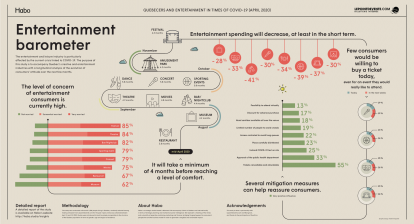New quarterly indicators released today by Statistics Canada provide an accurate measure of the profound impact of the COVID-19 pandemic on the live performance domain.
Brand new National Culture Indicators
Over the last year, CAPACOA has closely monitored the impact of the COVID pandemic using all possible sources of statistics. Today, as a member of the Culture Statistics Strategy Consortium, we are proud to announce the release of the National Culture Indicators. This new recurrent statistical program will deliver reliable and very accurate Gross Domestic Product and employment statistics, on a quarterly basis.
“This is a dream-come-true in matters of cultural statistics: timely and granular indicators reflecting what is actually happening in each domain of the cultural sector.”
Frédéric Julien, Director of Research and Development, CAPACOA
But this good news is also the bearer of bad ones.
Indicators for the fourth quarter of 2020
Last month, GDP statistics prepared by CAPACOA and reported by the Globe and Mail offered a bleak portrait of the situation in a statistical grouping that put in the same bucket performing arts, spectator sports and heritage sub-sectors. The National Culture Indicator trimmed out all non-performance activities to offer an even more accurate account of the situation in the live performance domain.
The Live Performance domain was the most impacted one among the culture sector.
At $286 million in the last quarter of 2020, the gross domestic product of the Live Performance domain had decreased 62,8% compared to 2019 ($768 million in the fourth quarter, non-annualized; $3,031 million for the entire year).
Live Performance is also the domain that took the largest hit from COVID-19 regarding employment, with a loss of 47% of jobs in the last quarter of 2020 (39,086) compared to 2019 (74,433).
Over the entire year, total employment in the live performance domain in 2020 (188,914) was 35.7% lower than in 2019 (294,012). This is a larger loss than what CAPACOA had been able to calculate with the Labour Force Survey.
Festivals and celebrations, a subdomain of live performance, had a particularly difficult year. Employment among festivals and celebrations in 2020 (10,203) fell 42.4% compared to 2019 (17,709).
“These numbers are disheartening. Live performance workers have been and are still under so much stress. We hope that the federal budget tabled next week will include further support for the sector.”
Sue Urquhart, Executive Director, CAPACOA

More information
Data tables are currently only available upon demand. Statistics Canada will publish a full article in The Daily, including data tables for the second NCI release, on June 28, 2021.
The National Culture Indicators (NCI) is a new extension product of the Provincial Territorial Culture Satellite Account (PTCSA) and the Provincial Territorial Culture Indicators (PTCI).
The PTCSA, PTCI and NCI flow from the Culture Satellite Account (CSA), an accounting framework developed to measure the economic importance of culture, the arts, heritage, and sport to the Canadian economy based on the Canadian System of Macroeconomic Accounts. The CSA provides credible estimates of culture Gross Domestic Product (GDP), jobs and total output by domain and sub-domain. Work on the CSA is conducted by Statistics Canada with the support of a diverse group of partners referred to as the Culture Statistics Strategy Consortium.
The domain classification in the CSA is different from the industry classification (the North American Industry Classification) used in regular macroeconomic statistical programs such as the Labour Force Survey. More details on the mapping between the CSA domains and the North American Industry Classification can be found in the Classification Guide for the Canadian Framework for Culture Statistics 2011.
If you would like to learn more about the CSA, this short video explains the three components of the CSA.








